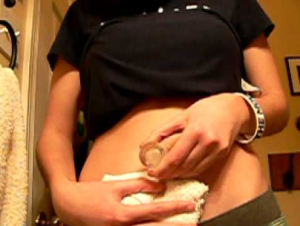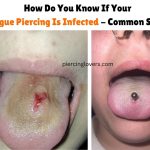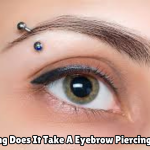Belly button piercings are a popular and stylish form of body art. However, they can sometimes lead to discoloration around the piercing area, which can be concerning and affect your confidence. This article will guide you through the steps to get rid of discoloration around your belly button piercing and maintain healthy skin.
Here Are A Few Steps to Get Rid of Discoloration
Clean the Area Regularly
Daily Cleaning: Keeping the area clean is crucial. Use a saline solution or a gentle antibacterial soap to clean the piercing twice a day. Harsh chemicals like alcohol or hydrogen peroxide should be avoided as they can irritate the skin and slow down the healing process.
How to Clean Around Belly Button Piercing:

So to get rid of discoloration in belly button piercing you should clean it regularly and here is a brief effective way how you can clean around belly button piercing.
- Soak a cotton ball or pad in the saline solution or antibacterial soap.
- Gently dab around the piercing, avoiding excessive rubbing which can cause irritation.
- Make sure to rinse thoroughly with clean water.
- Pat the area dry with a clean towel. Avoid using the same towel multiple times to prevent the spread of bacteria.
Use Antibacterial Ointment
Applying a thin layer of over-the-counter antibacterial ointment can help prevent infection and promote healing. Make sure your hands are clean before applying the ointment to avoid introducing new bacteria to the area.
- Wash your hands thoroughly.
- Apply a small amount of ointment on a clean fingertip or cotton swab.
- Gently spread the ointment around the piercing.
Avoid Irritation
Clothing: Wear loose-fitting clothes to avoid friction around the piercing area. Tight clothing can cause rubbing, leading to irritation and discoloration.
Jewelry: Use high-quality jewelry made from hypoallergenic materials such as surgical steel, titanium, or gold. Avoid nickel, which is a common allergen and can cause reactions leading to discoloration.
Apply Natural Remedies
Aloe Vera: Aloe vera is known for its soothing properties. It can help reduce inflammation and discoloration. Apply pure aloe vera gel to the affected area and leave it on for 20-30 minutes before rinsing off with lukewarm water.
Vitamin E Oil: This oil is known for its skin healing properties. Gently massage a few drops of vitamin E oil into the skin around the piercing twice a day. This can help repair damaged skin and reduce discoloration. But remember if you are in pregnancy stage then you should treat your belly button piercing in different ways. So you can read our article which is about “pregnancy and belly button piercing“, there you you will get all of you answers.
Stay Hydrated and Eat Healthily
Drinking plenty of water and eating a balanced diet rich in vitamins and minerals supports skin health and healing. Foods rich in vitamins A, C, and E, as well as zinc, can be particularly beneficial for skin repair.
- Hydration: Aim to drink at least 8 glasses of water a day.
- Diet: Include plenty of fruits, vegetables, nuts, and seeds in your diet to provide your skin with the nutrients it needs to heal.
Avoid Touching and Twisting the Jewelry
Touching or twisting the jewelry can introduce bacteria and irritate the piercing, leading to further discoloration. Only touch your piercing with clean hands when necessary, such as during cleaning.
- Avoid playing with the jewelry, especially with dirty hands.
- Be mindful of activities that might cause the jewelry to move excessively.
Consult a Professional
If discoloration persists or worsens, it’s important to seek advice from a healthcare professional or a reputable piercing studio. They can provide tailored advice and treatment options.
- Piercing Studio: Visit your piercer for a professional opinion. They can check for any signs of infection or improper healing.
- Healthcare Professional: If you suspect an infection or severe allergic reaction, consult a doctor who can prescribe appropriate medications or treatments.
Preventive Measures
Proper Aftercare: Follow the aftercare instructions provided by your piercer diligently to ensure proper healing and prevent complications. This typically includes cleaning routines and avoiding certain activities that might stress the piercing.
Regular Check-ups: Visit your piercer for regular check-ups, especially if you notice any changes in the piercing area. Regular monitoring can catch potential issues early before they lead to significant discoloration.
By following these steps, you can effectively manage and reduce discoloration around your belly button piercing. Remember, patience and consistency are key in the healing process. Take care of your piercing, and enjoy your stylish belly button jewelry without worry!
Frequently Asked Questions
Q: What causes discoloration around a belly button piercing?
A: Discoloration can be caused by several factors including infection, scarring, allergic reactions to the jewelry, and poor hygiene. Understanding the underlying cause is essential for proper treatment.
Q: How often should I clean my belly button piercing?
A: You should clean your belly button piercing twice a day using a saline solution or a gentle antibacterial soap. Consistent cleaning helps prevent infections and reduces the risk of discoloration.
Q: Can I use alcohol or hydrogen peroxide to clean my piercing?
A: No, alcohol and hydrogen peroxide can be too harsh and irritate the skin, potentially slowing down the healing process and contributing to discoloration. It’s better to use saline solution or a mild antibacterial soap.
Q: What type of jewelry should I use to avoid discoloration?
A: Use high-quality jewelry made from hypoallergenic materials such as surgical steel, titanium, or gold. Avoid jewelry made from nickel, which can cause allergic reactions and discoloration.
Q: How can natural remedies like aloe vera and vitamin E oil help?
A: Aloe vera has soothing and anti-inflammatory properties that can reduce redness and discoloration. Vitamin E oil is known for its skin healing properties and can help repair damaged skin, reducing discoloration over time.
Q: Should I avoid certain activities while my piercing is healing?
A: Yes, avoid activities that cause excessive movement or friction around the piercing area, such as rigorous exercise or wearing tight clothing. These activities can irritate the piercing and contribute to discoloration.
Q: How long does it take for discoloration to go away?
A: The time it takes for discoloration to fade varies depending on the cause and how well you care for your piercing. With proper care, you might see improvement in a few weeks to a few months. Persistent discoloration may require professional treatment.
Q: Can diet and hydration really affect the healing of my piercing?
A: Yes, staying hydrated and eating a balanced diet rich in vitamins and minerals supports overall skin health and can speed up the healing process. Vitamins A, C, E, and zinc are particularly beneficial for skin repair.
Q: When should I seek professional help for discoloration?
A: If the discoloration persists or worsens despite your care, or if you notice signs of infection such as severe redness, swelling, pain, or pus, seek advice from a healthcare professional or your piercer.
Q: Is it normal for a piercing to have some discoloration during the healing process?
A: Some mild discoloration can be normal during the initial healing phase, as the body adjusts to the new piercing. However, if the discoloration is severe or accompanied by other symptoms like pain or swelling, it could indicate a problem.
Q: Can I remove the jewelry to treat discoloration?
A: It’s generally not recommended to remove the jewelry on your own, especially if the piercing is still healing, as it can cause the piercing to close or become infected. Consult your piercer or a healthcare professional for advice before removing the jewelry.
Q: What can I do to prevent future discoloration once my piercing has healed?
A: Continue to practice good hygiene, avoid exposing the piercing to harsh chemicals, and choose high-quality jewelry. Regular check-ups with your piercer can also help catch any issues early on.




Pingback: Does It Hurt To Get Belly Button Re Pierced - Second Time Piercing?